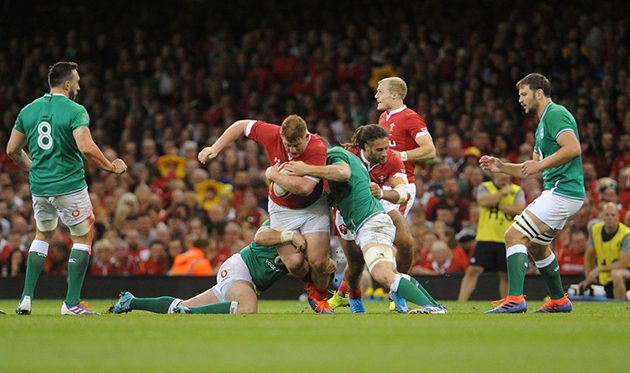From front-rows to emergency tens and failed drug tests, Paul Williams assesses rugby's latest goings-on
The rise of Rhys Carre
If you’ve ever seen Rhys Carre, it may seem strange to suggest that he has ‘risen’ from anywhere. He looks like he was born like that and thus perfect for a career in rugby. He is massive for a 21-year-old.
Whilst his physical stature clearly hasn’t gone unnoticed in the Wales camp, his inclusion in the World Cup squad was a surprise for even his biggest supporters.
.@RhysCarre: "It's been a whirlwind six months for me" ?️
We caught up with the young loosehead from Cardiff at Wales' training camp in Turkey. #HWFN pic.twitter.com/dzhxMXoyca
— Welsh Rugby Union ? (@WelshRugbyUnion) August 28, 2019
However, don’t for one second think that he merely uses his weight as flesh-scaffold holding up a scrum; he is so much more that. Carre is a loosehead who carries like a No 8.
And whilst his selection may seem premature, he could have a big impact should he be required. If you need any further evidence, just look at Saracens’ recruitment history over the past five years. They don’t buy anything that isn’t Test standard and beyond – and they’ve just bought him.
Test players shouldn’t be failing drug tests
When a young player fails a drug test, my initial response is to feel sorry for that individual. The potential and desire for that athlete to succeed often supersedes the seriousness of what they have done, and age-grade players are more susceptible to doping.
However, that is not the case when you become a Test player. As a Test player, you have access to the best doctors and supplement manufacturers in the world. To risk throwing away your career by taking performance-enhancing drugs is as naïve as it is stupid.

Wide man: Wing Aphiwe Dyantyi on the attack for the Springboks last year (Getty Images)
South Africa’s Aphiwe Dyantyi was one of, if not the, most exciting wings in the world last season. He was my favourite player to watch for 12 months.
Then last week news broke that he had returned a positive drug test and faces a four-year ban. Dyantyi released a statement that said: “I want to deny ever taking any prohibited substance, intentionally or negligently, to enhance my performance on the field. I believe in hard work and fair play. I have never cheated and never will.”
Dyantyi is set to fight the charge, but the odds are against him. He could go from the 2018 World Rugby Breakthrough Player of the Year to 2019’s biggest career breakdown.
Front-rows under scrutiny for the World Cup
When Rugby World Cup squads are selected, the paying public are usually obsessed with which outside-halves have made the cut, which back-row players will travel and which back-three players won’t. But this year’s squads have been slightly different.
Many of the big omissions have been at prop. Owen Franks, Rob Evans and Samson Lee have arguably been the highest profile causalities, and this shows how the role of the prop has changed over the past decade.

Long server: Owen Franks was left out of New Zealand’s World Cup squad (Getty Images)
Props are no longer just big lumps who anchor the scrum. They’re now ball-carriers, the third or fourth jackler and, in some cases, a well-disguised second receiver.
The fact that Franks, Evans and Lee haven’t made the squads is no comment on their skill or ability, but on the reality of them being able to do it over six weeks.
Props can no longer carry a string of injuries. Such is the intensity of their role that they have to be some of the most robust players on the field. And thus, many of the leading coaches are selecting younger, fresher options.
Professional sport can be a cruel game.
Emergency tens are key for Japan 2019
Like a spare pair of underpants in case of an accident, the emergency outside-half is rarely used but vital should you need them. The past two weeks have seen Garry Ringrose selected as an emergency ten by Ireland and we’ve also learnt that Liam Williams would be called into that position for Wales should the situation require it.

New role? Garry Ringrose could be used as a fly-half by Ireland (Getty Images)
The discussion of the emergency ten is never more pertinent than during a World Cup, where tight squads and the inevitable injuries mean the teams that fly out to Japan will have very different boarding passes to those who come home.
Both Williams and Ringrose have the skill-set to be an emergency ten. Their goalkicking percentage will be above 70%, they have good line kicking skills and neither would let much through the ten channel.
With a bit of luck, no team will need their emergency pants, but when things get a bit scary, Warren Gatland and Joe Schmidt will be glad to have a spare pair in the kit bag.
All Blacks couldn’t risk three young centres
Ngani Laumape wasn’t selected in the New Zealand squad for Japan 2019, in a season when he really couldn’t have done much more to impress. Steve Hansen instead opted for more senior options in midfield.

Attacking threat: Ngani Laumape is tackled during New Zealand’s win over Argentina (Getty Images)
It wasn’t an easy decision. Play Sonny Bill Williams, who has done it all for many a season but not this season. Or pick Laumape, who hasn’t been around for that long but who lives a long time in a defence’s memory.
Should the All Blacks not win this World Cup, the centres selection may be one of those that receives the most scrutiny. But with Jack Goodhue and Anton Lienert-Brown both only 24, Hansen felt the need to opt for experience in SBW and Ryan Crotty.
Follow Rugby World on Facebook, Instagram and Twitter.





